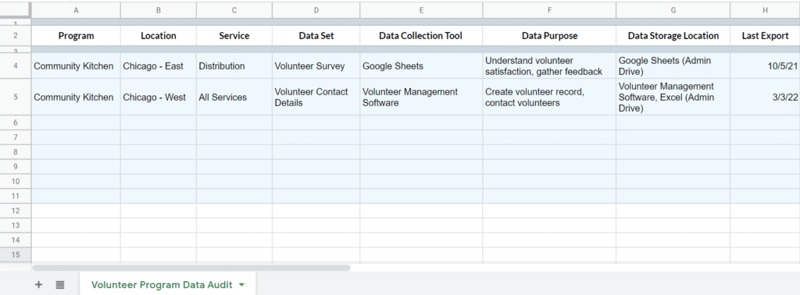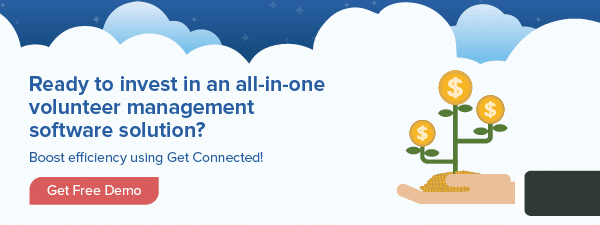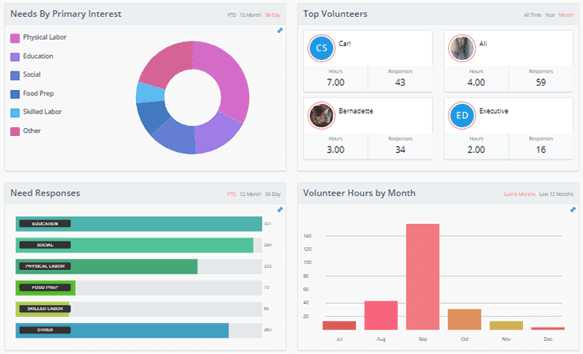Ah, data. For some, just the word data induces feelings of dread. For others, managing data seems like a tedious task they’d rather put off. And we don’t blame you!
But tracking and organizing volunteer and donor data is a critical part of managing your volunteer program. Why? Robust data can lead to significant and tangible results.
Managing your program’s data doesn’t have to be a source of anxiety. With the right tools and processes in place, your data can actually work for you!
We spoke with Galaxy Digital’s Data Experts to bring you winning strategies for capturing, storing, and leveraging your volunteer program data.
Article Contents:
How to Evaluate Your Volunteer Program Data
Before we dive into what kinds of data you need and the tools best to collect and store data, let’s learn more about the data you currently have.
One of the best ways to evaluate the data you have is to perform a data audit:
All About Data Audits
Yes, a data audit: a practice best left to major corporations and the IRS, right? Wrong! Any organization of any size can perform a data audit. After all, auditing your data is really about evaluating the quality of the data you have and determining the data you need.
What is a data audit?
A data audit is a systematic review of your organization’s data collection activities. A data audit can help you make sense of the data you have, ensure your information is accurate, and understand what gaps in your collection exist.
Many organizations use multiple systems to organize and manage volunteers—therefore, collecting data from multiple sources. A data audit encourages organizations to centralize data insights and improve reporting quality across the program.
Why should you conduct a data audit for your volunteer program?
Strong, organized data is critical to the sustainability and growth of any volunteer program and nonprofit.
Data audits can help you uncover key insights, such as:
- The accuracy and efficiency of your program’s data collection methods
- Duplicate and missing records
- Successful volunteer retention strategies
- Causes and sources of volunteer attrition
By implementing a data-driven strategy, you can make more informed decisions about program management. Access to robust data can also help you improve your return on investment and win funding opportunities.
Follow these steps for evaluating your data:
1. Determine Your Scope
Are you evaluating one program’s data? Multiple programs? Data associated with a specific region? Your entire organization? You simply need to decide which set of data you’re looking into before you begin.
Once you’ve determined the extent of your data audit, you can zero in on the data sets that you’re currently capturing.
2. List the Data Sets You’re Currently Collecting
Next, you’ll need to gather the data sets you currently have and the location in which you’re collecting them. Consider the following:
- What data sets are you collecting within the scope of your audit?
- Which systems are you using to collect this data?
- Where is this data stored?
For example, your data sets may include volunteer contact details, individual volunteer hours, program volunteer hours totals, and attendance records from your volunteer management software.
Use a spreadsheet like the one below to list your data sets and sources. This exercise will give you a more holistic sense of your organization’s data.

3. Identify How Each Data Set Is Used
Once you know where all your data lives, you’ll want to evaluate how each set of data is used. Gather your team to discuss, as there’s a chance staff may be using your data differently. Then, record how each data set is used (as in the example above).
For example, your volunteer intake form serves the purpose of capturing contact details for volunteer leaders and demographic information for making key marketing decisions.
4. Run Exception Reports
Exception reports will point to irregularities and gaps in your data collection processes. You can run a report that shows every record where a field is left blank. If you collect the same data from two locations, run an exception report to identify inconsistencies.
Some software, like your CRM, may have an automated exception report function built-in. You can also export your data into excel and use the Reporting Wizard tool.
5. Look for Duplicate and Outdated Data
Duplicate and outdated data will significantly impact reporting accuracy. So, you’ll want to “clean” your data by identifying information that is redundant or no longer useful.
Then, decide which data you’d like to remove and which to keep. For example, you may choose to keep the data associated with inactive volunteers for two years. Establish a set of criteria for cleaning your data to ensure consistency.
You can find and remove duplicates in Excel and Google Sheets. Some of your data capturing tools, like your volunteer management software or CRM, may help you identify and avoid creating duplicate data entries by employing unique identifiers (such as email addresses or ID numbers).
6. Check for Accuracy
Your data is only beneficial if it’s precise. Check for accuracy by comparing data from different months or days year over year. Do the trends match what you’d expect? Do your results seem drastically higher or lower than they should be?
Look at your data summaries to find these values in your data set:
- Minimum
- Maximum
- Average
These values are useful for finding outliers and entry mistakes in the data that may be inflating totals and averages.
7. Evaluate Data Security
You’re capturing sensitive data, from volunteer contact details to background checks. Therefore, it’s essential that this information doesn’t end up in the wrong hands.
Start by answering the following questions. If you’re unsure of any answers, it may be time to rethink how you capture and store your data (more on storing data later in this article):
- Who has access to your data?
- How often are you backing up your data? Is backup automatic or manual?
- Are hard copies stored in an organized, secure system?
- Are you storing digital copies of hard copies?
- Are your computers and devices password protected?
- Is your data cloud-based? If so, who owns the server?
- How is your digital data shared from party to party?
- Where do data exports live? How often are you exporting your data?
>>> For more comprehensive guidelines on keeping your organization’s data safe, check out Cybersecurity for Nonprofits from the National Council of Nonprofits.
8. Review Your Data Collection Processes
If you come across missing or duplicate data frequently, it may be time to review some of your processes. Are there places where you’re collecting the same data twice? Which data sets are serving a similar purpose?
After auditing your data, you’ll have a better sense of your organization’s most pressing needs. If you’re losing data or unable to make sense of the data you have, you may need to reevaluate how and when you’re collecting key data.
Keep reading to learn how to capture the essential data:
How to Capture the Data You Need
After evaluating the current state of your data, you’re probably left wondering what data does my volunteer program really need?
Gather your team and results from your data evaluation. Then, start by looking at the big picture:
- What are your goals for the month, the year, and even five years from now?
- What information do you need to deliver your mission?
- What do you need to know about your volunteer program to make critical decisions?
Each data set should serve a purpose, whether that purpose is to inform critical decision-making, apply for funding, or meet program goals.
Your volunteer program will have unique data needs. However, most organizations benefit from collecting the following data sets:
- Volunteer information – Gather identifying information like names, addresses, email, phone numbers, and demographics.
- Volunteer preferences – Record volunteer preferences, interests, skills, and feedback.
- Volunteer networks – Tap into your volunteers’ networks by gathering data on the company, church, universities and community groups they belong to.
- Hours – Track hours for each volunteer, service, and program.
- Event data – Capture attendance records for each event.
- Donor data – Track your volunteers’ monetary contributions in addition to their time.
- Clients served – Understand how your volunteer program impacts your clients and community by logging client information, such as the number of clients served and demographic data.
- Program outcomes – Record the qualitative and quantitative metrics that align with intended program outcomes. Your records may include client stories and surveys.
- Digital engagement – Leverage your social media and email tools to understand how your audiences interact with your digital content.
When to Collect Volunteer Program Data
You’ll collect better data when your strategy is focused and timing on point! Capture volunteer data during these key touchpoints:
- Volunteer registration – This is the best time to collect basic volunteer information. Record names, contact details, and preferences, including skill sets and preferred causes.
- Check-in and check-out – Record volunteer attendance and hours when volunteers check-in and out of their shifts. Create a centralized location and system (like a check-in station) so that you’re catching each volunteer as they arrive on site.
- Follow-up – Many programs choose to collect data within a few days of a volunteer serving. An automated email follow-up is a great way to encourage volunteers to log their hours, ask how their experience went, and thank them!
- Volunteer surveys – Volunteer surveys are instrumental in gathering qualitative data. From volunteer satisfaction surveys to feedback questionnaires, the best programs tap into the experiences and knowledge of their supporters.
Storing Your Data
You know what data you need, but where should you keep your data? Many organizations choose to store their data in multiple formats:
Paper Forms and Hardcopies
From questionnaires to attendance sheets, you may have paper forms that you need to process and store.
While seemingly simple to collect, paper data can easily become difficult to keep organized and updated. Set aside time once a month or per quarter to update your paper records. Because physical space may be limited, you’ll want to review and discard outdated hard copies annually safely.
You may consider transferring your hardcopies to a digital format. While this process can be time-consuming, digital data is much easier to maintain.
Digital Data
There are several ways you can store and access digital data:
- Personal Hardrive: If your data is stored on a private hard drive, your data can only be accessed by those who have access to the hard drive or computer. For example, you may store your data in excel and save it in your personal files. Consider putting in place a system for sharing with others to ensure appropriate access to your data.
- Shared Files: All individuals who have access to the shared drive can access these files. If you’re sharing files, you want to consider the security of your shared storage system. Do you know who has access to these files? Are their privacy and security measures in place to safeguard sensitive data, like volunteer and donor information?
- Database, Application, and Online Software: The good news is that if you purchase trusted software, they have systems to secure data. Talk to your software provider about their security measures and data-sharing policies. Most systems are password-protected, giving you more control over accessibility.
Tools for Capturing Volunteer Data
Set your organization up for success by putting in place systems that simplify data collection:
Email Marketing Tools
One way to stay on top of your volunteer program marketing strategy is to ensure your email database is organized. This may mean employing a paid email system or constituent relationship management (CRM) system. CRMs help you capture contacts, compile strategic email marketing campaigns, and provide powerful data insights.
>>> Learn more about employing a CRM system.
Survey Tools
A volunteer survey is a worthwhile addition to any organization’s toolbox. Surveys are a great way to gather data and analyze your volunteer program, and they tend to lend themselves to relatively high return rates.
Online survey tools tend to be the easiest way to distribute forms and collect results. And the good news is there are plenty of free online survey tools out there.
Web-Based Sign-Up Tools
If you’re looking for a simple, inexpensive way to track volunteer attendance, web-based sign-up sheets and event organizers might be the way to go. These tools will give you very simple information like day-of attendance and hours. While you won’t get the robust data you need to track your long-term goals, they’re a great place to start for programs that are new to web-based systems!
Does your tech need an upgrade? Take this quiz to find out!
Volunteer Management Software
The best, most cost-effective tools centralize and integrate multiple systems and touchpoints. That’s where volunteer management software comes in. Volunteer management software can actually take the place of many disparate volunteer management tools, including email platforms, online sign-up tools, and survey forms.
A robust system can simplify attendance and automate hours tracking. So, it can not only help you capture the comprehensive data you need, but it will also help you analyze your data.
Ultimately, having the right tools to capture your data will save you time and improve the quality and accuracy of your data, resulting in better outcomes for your volunteer program.
Tips for Adopting New Digital Systems
When adopting a new digital system, such as a volunteer management system or CRM, you’ll probably need to transfer your data. Work with your service provider to get your data into a format (such as an excel spreadsheet) that is transferable to your new system. This is also a great time to comb through your data. So, give yourself time to switch systems and get data in order.
Follow these tips for choosing the best volunteer management software.
How to Leverage Your Data
What can your data tell you? Robust data can empower you to identify opportunities for growth and enact change. By leveraging your data, you can:
- Target volunteer recruitment efforts
- Boost volunteer retention and engagement
- Direct resources
- Secure and maintain funding
- And more!
Target Volunteer Recruitment
Casting a wide net and calling all volunteers can be an effective strategy if you need volunteers in droves. But more often, you probably need the right volunteers for the job.
Let’s say your goal is to expand your after-school tutoring program, which already relies on a core group of weekly volunteers who are vetted and trained. You need to know which volunteers have already participated before re-engaging them, and you also need to direct your volunteer recruitment efforts to find new volunteers. Comprehensive data—like contact information, participation records, demographic insight—will help you direct recruitment efforts efficiently.
In other words, you can target your approach to volunteer recruitment by enlisting the help of your data. A volunteer intake survey can tell you how skilled volunteers are finding you to direct your marketing strategy. What’s more, your email marketing and social media data will help you make sense of the types of content and calls to action that are most successful.
Boost Volunteer Retention and Engagement
Your supporters want to know that their efforts lead to real change in your community.
One of the best uses of your data is to demonstrate impact and recognize contributions.
A volunteer management system will capture hours and impact data for each volunteer. And some systems will even automatically acknowledge volunteers who reach certain milestones. You can also leverage the system to track participation to work to re-engage lapsed volunteers.
Your volunteer survey results will give you insight into volunteer satisfaction so you can make decisions to improve volunteer retention.
Direct Resources
By tracking service and program-specific data, you’ll glean insights to help you direct funding and resources toward the most impactful activities.
Use your data on where your volunteers are spending the most time. Which programs are the most popular among volunteers? What are your volunteers’ favorite causes? Review your impact metrics, program outcomes, and client stories to understand where your services are most effective and the areas that need improvement.
Secure and Maintain Funding
Your data is powerful. It can unlock funding opportunities that enable growth. You need reliable and accurate data to prove to funders that their contributions go toward a worthy cause.
You’ll not only win grants with your data, but you’ll also earn more resounding support and engagement from donors, volunteers, and other community stakeholders. Use your data to communicate your impact and share your success stories.
Read about how this nonprofit leveraged their data to win $500,000 in grant funding:
Success Story: Tracking Volunteer Hours Leads to $500,000 FEMA Grant for Volunteer Center
In response to the coronavirus pandemic, The City of Albuquerque, New Mexico, sprang into action to support its citizens through volunteerism. The city’s Volunteer Center, One Albuquerque, logged 20,000 volunteer hours (and counting). By tracking their data using a dedicated volunteer management system, One Albuquerque was able to apply for and receive a $500,000 FEMA grant!
Albuquerque’s Mayor Keller went live on the news requesting volunteers to log their hours to bring in federal funds. The Mayor gave instructions on how to head to their online volunteer site, register as a volunteer, and log their hours – thus inspiring the community to get involved.
Because they had a data plan, researched grants they were eligible for and were consistently using volunteer management software to log hours – the City of Albuquerque was able to earn an impressive grant that helped them make an even bigger impact.
Learn more about the City of Albuquerque’s dedicated volunteer management software: Get Connected.
Your data is about so much more than just numbers: It empowers you to grow your impact. That’s why volunteer programs need the know-how and tools to manage data effectively and efficiently.
Additional Resources
How Volunteer Data Can Unlock Funding
The Importance of Communicating Volunteer Impact
Streamline Your Volunteer Registration Process with Smart Technology








